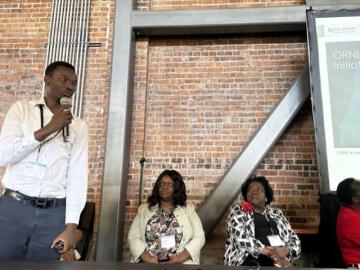
Filter News
Area of Research
- Advanced Manufacturing (3)
- Biology and Environment (58)
- Biology and Soft Matter (1)
- Computational Biology (1)
- Computational Engineering (1)
- Computer Science (1)
- Energy Science (82)
- Fusion and Fission (13)
- Fusion Energy (1)
- Isotopes (22)
- Materials (59)
- Materials for Computing (10)
- National Security (29)
- Neutron Science (99)
- Nuclear Science and Technology (12)
- Quantum information Science (1)
- Supercomputing (68)
News Type
News Topics
- (-) Advanced Reactors (25)
- (-) Clean Water (19)
- (-) Composites (24)
- (-) Cybersecurity (31)
- (-) High-Performance Computing (114)
- (-) Isotopes (55)
- (-) Neutron Science (139)
- (-) Simulation (54)
- (-) Transportation (61)
- 3-D Printing/Advanced Manufacturing (108)
- Artificial Intelligence (114)
- Big Data (58)
- Bioenergy (95)
- Biology (108)
- Biomedical (61)
- Biotechnology (36)
- Buildings (50)
- Chemical Sciences (72)
- Computer Science (180)
- Coronavirus (37)
- Critical Materials (17)
- Education (5)
- Element Discovery (1)
- Emergency (3)
- Energy Storage (80)
- Environment (162)
- Exascale Computing (64)
- Fossil Energy (7)
- Frontier (61)
- Fusion (56)
- Grid (50)
- Hydropower (6)
- ITER (6)
- Machine Learning (53)
- Materials (113)
- Materials Science (120)
- Mathematics (9)
- Mercury (9)
- Microelectronics (4)
- Microscopy (44)
- Molten Salt (5)
- Nanotechnology (50)
- National Security (81)
- Nuclear Energy (99)
- Partnerships (67)
- Physics (65)
- Polymers (25)
- Quantum Computing (48)
- Quantum Science (80)
- Security (30)
- Software (1)
- Space Exploration (16)
- Statistics (3)
- Summit (62)
Media Contacts

The National Center for Computational Sciences, located at the Department of Energy’s Oak Ridge National Laboratory, made a strong showing at computing conferences this fall. Staff from across the center participated in numerous workshops and invited speaking engagements.

A research collaboration between the Department of Energy’s Oak Ridge National Laboratory and several partner institutions was honored with the Best Event Report award at the 2024 International Conference on Game Jams, Hackathons and Game Creation Events.

FREDA is a new tool being developed at ORNL that will accelerate the design and testing of next-generation fusion devices. It is the first tool of its kind to combine plasma and engineering modeling capabilities and utilize high performance computing resources.

The Department of Energy’s Oak Ridge National Laboratory had a major presence at this year’s International Conference for High Performance Computing, Networking, Storage, and Analysis (SC24).


ORNL researchers reached a significant milestone by building an entire 6.5-foot turbine blade tip using novel materials. The team then tested it against the forces of simulated lightning in a specialized lab at Mississippi State University, where the blade tip emerged pristine after tests that isolate the effects of high voltage.

In early November, ORNL hosted the International Atomic Energy Agency (IAEA) Interregional Workshop on Safety, Security and Safeguards by Design in Small Modular Reactors, which welcomed 76 attendees representing 15 countries, three U.S. national labs, domestic and international industry partners, as well as IAEA officers.

A chemical reaction can convert two polluting greenhouse gases into valuable building blocks for cleaner fuels and feedstocks, but the high temperature required for the reaction also deactivates the catalyst. A team led by ORNL has found a way to thwart deactivation. The strategy may apply broadly to other catalysts.

This year’s Association for Computing Machinery’s Gordon Bell Prize in supercomputing goes to researchers led by the University of Melbourne who used the Frontier supercomputer to conduct a quantum molecular dynamics simulation 1,000 times greater in size and speed than any previous simulation of its kind.

In early November, researchers at the Department of Energy’s Argonne National Laboratory used the fastest supercomputer on the planet to run the largest astrophysical simulation of the universe ever conducted. The achievement was made using the Frontier supercomputer at Oak Ridge National Laboratory.


